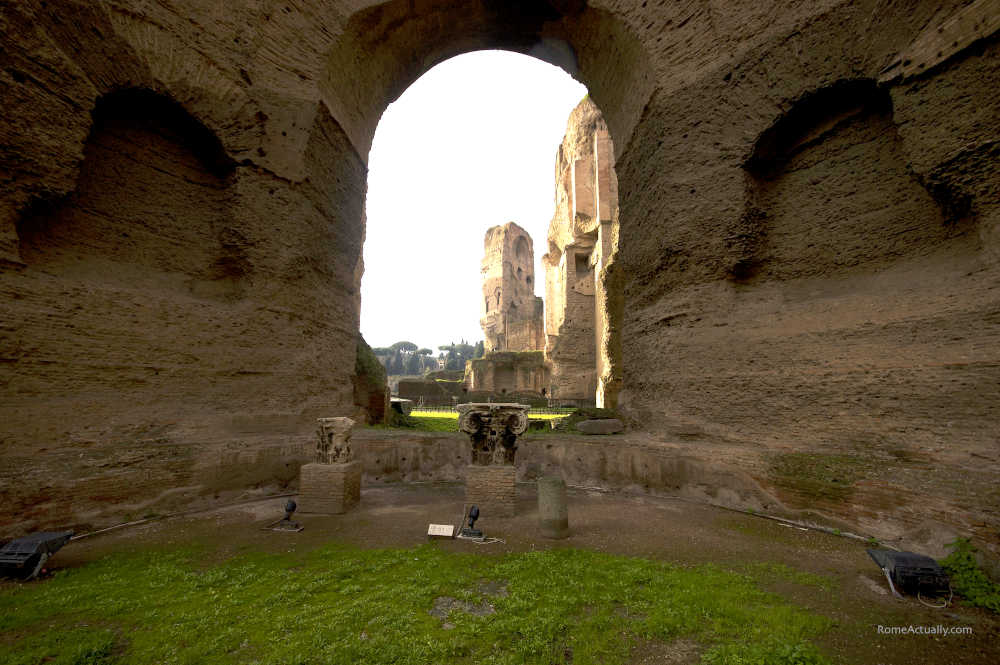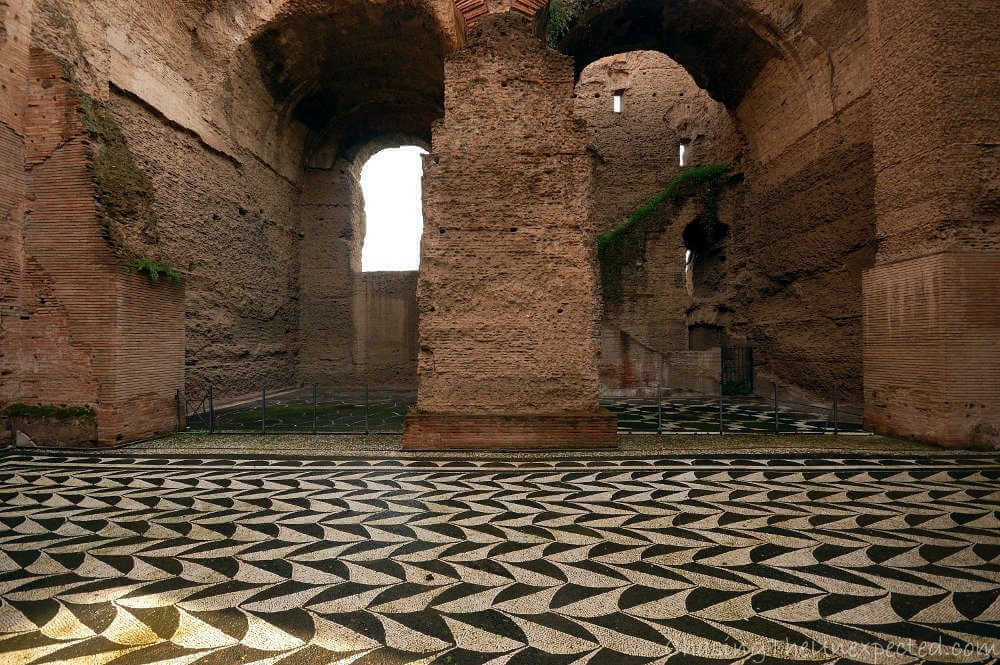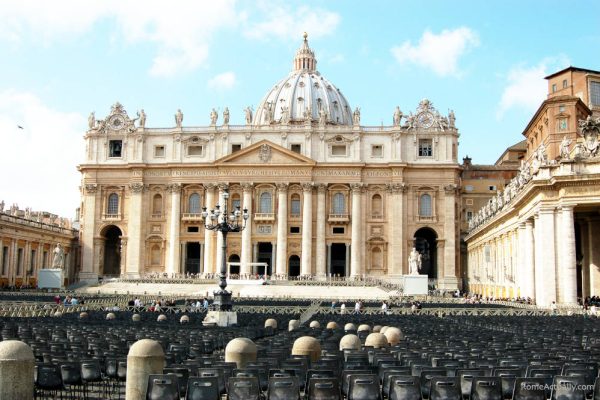For anyone traveling to Rome for the first time, visiting the Colosseum is a must. But how many stray a bit further south towards the Circus Maximus to visit the wonderful Baths of Caracalla? Even though not really a hidden gem in Rome, this is one of the thousand-year-old attractions and one of Rome’s best archaeological sites where you will find virtually no queue.
Also called Thermae of Caracalla, these Roman baths were built by emperor Caracalla to show off in architecture, style, and luxury, and to allow the citizens to enjoy the public spa that nowadays in summer becomes the scenic backdrop for the Opera plays.
The 90-foot-tall thermal bath complex had a capacity of around 6,000 enthusiast spa-goers at a time, functioning also as a social hangout, and discovering the labor behind its operations and its fantastic architecture and decorations is one of the top experiences to have in Rome.

History of the Baths of Caracalla in Rome
Gone down in history as Thermae Antoninianae, the Baths of Caracalla were commissioned by emperor Caracalla himself in 212 AD. It took 5 years and 9,000 workers to build what now is one of the biggest and best-preserved thermal baths of ancient Rome. Inaugurated in 216 AD, the thermal spa was operative until 537, when Gothic King Vitige severed the aqueducts to conquer the city by thirst.
Built in the southern side of the ancient city of Rome, even though the Baths of Caracalla were inaugurated in 216 AD, the works went on for another year, even after the death of Caracalla himself. The last emperors of the Severan dynasty, in fact, Heliogabalus and Alexander Severus, completed the huge complex by building the external fence.
The area where this large thermal complex was built had previously been urbanized by the same emperors of the Several dynasty with the construction of the Via Nova running on the northern side of the baths and what was known as Septizodium. This was a beautiful nymphaeum built on the slopes of Palatine Hill as a scenic backdrop to the beginning of the Appian Way.
The copious amount of water was supplied by a special branch of the Aqua Marcia aqueduct called Nova Antoniniana. On the southern side of the baths, the ruins of the giant water cisterns are still visible.
The original baths were finely decorated with hundreds of statues, paintings, and mosaics.

Wellness experience in the Baths of Caracalla
In its heyday, the main entrances would open on the natatio, an Olympic-size swimming pool with warm water all year round. With an Olympic-size swimming pool, the natatio was also a monumental room. Its northern facade was divided into three parts with giant grey pillars. Each side featured six nooks that contained large statues over two levels, three nooks for each level. The bottom one was made of Caristio marble and the upper with Granito del Foro, a colorful granite stone largely used to make pillars in Roman times.
The experience of an average spa-goer would start in the changing rooms and the gym.
Once they were done with the physical activity, bathers would enter the laconium to have a sauna and prepare the body for the hot temperatures of the calidarium, the warm room heated through a powerful system known as hypocaustum that issue hot air under the floor.
From here, a quick stop in the tepidarium before entering the coolest room of the baths, the frigidarium. This was the most opulent room of the whole complex covered with a sumptuous triple cross vault.
The whole plan of the complex, rectangular in shape typical of the imperial baths, was organized with the thermal baths arranged on a single axis and functional to the sun exposure. The changing rooms and the gyms were doubled and symmetrical to allow a smoother passage for the thousands of bathers.
All around, the northern side was left for the shops (tabernae) and the southern part for two libraries, one of which is still visible.

What to see inside the Caracalla Baths
Calidarium, tepidarium and frigidarium
A typical spa day in the Baths of Caracalla started at the gym, followed by a sauna session. After that, the experience would continue with the actual spa treatment route which consisted of three separate sessions.
First was the calidarium, a warm room heated by an efficient heating system of hot air under the floor. This was a large dome-covered round hall with tubs in the niches on the walls. Once citizens were done here, they would move into the tepidarium to start bringing the body’s temperatures down. Finally, the frigidarium was the cooler room with cold water pools and a play of waterfalls.
This monumental hall, the frigidarium, was similar to the structure of a basilica and was a source of inspiration for many buildings afterward, such as the Baths of Diocletian, where is now the important Museo Nazionale Romano, and the Basilica of Maxentius inside the Roman Forum.
Thanks to its central position, the frigidarium was used as a meeting point for the visitors of the baths before they made their way to the other rooms of the complex. In this giant room, visitors enjoyed covered cold baths, two of which were connected to the natatio room through waterfalls.
Make sure you read our article about the most important museums in Rome.

Mosaics and sculptures: decoration of the Caracalla Baths
The Baths of Caracalla were a feast for the eyes, too. The decoration included pillars, pavements embellished with colorful marble mosaics oriental-style, and wall ornaments made of fine marble, as well as beautiful glass paste mosaics on the vaults.
The adornments included also painted stuccoes and hundreds of statues decorating the niches in rooms, halls, and gardens, as well as several monumental sculptural groups. Some statues were made of bronze but mainly they were of painted marble.
The pavements of the upper floor were decorated with marine mythological figures and monsters, Nereids, tritons and dolphins.

Unfortunately, from the Middle Ages, several pieces of the local artwork were looted and removed from their original context, making these wonderful baths an exclusive supply of building materials for churches and private collections.
Today, at the Museo Archeologico of Naples you can find some sculptures from this luxurious thermal complex, including the huge sculptural group known as Toro Farnese discovered during the diggings promoted by Pope Paul III Farnese between 1545 and 1547. Toro Farnese was carved out of a single, giant marble block and represents the torture of Dirce tied to a bull by twins Amphion and Zethus to avenge their mother Antiope.
In Piazza Santa Trinità in Florence there is a huge column from the natatio brought by Cosimo de’ Medici in 1563, while in Piazza Farnese, behind Campo de’ Fiori, you can see two grey granite basins from the original frigidarium now employed as fountains.
You can find carved capitals also in Pisa’s Duomo and in the Basilica of Santa Maria in Trastevere in Rome, while many sculptures became part of several private collections, including the one of the Farnese family.
In 1824, archaeologists discovered floor mosaics representing athletes used to decorate the gyms and are now kept in the Vatican Museums, while one of the latest discoveries, a statue of Artemis, is displayed at the Museo Nazionale Romano in Rome.
Underground
One of the most fascinating sights in the Baths of Caracalla is its undergrounds. Here, you can see a wide network of tunnels suitable for vehicles (carriages) where the stocks of wood, the heating system made of ovens and furnaces, and the lead pipes of the hydric system in smaller tunnels were.
At the beginning of the 20th century, in the underground level of the Baths of Caracalla, they discovered a beautiful Mithraeum, a sanctuary devoted to the Persian god Mithra. The cult of Mithra was introduced into the Roman society around the 1st century and was most widespread during the same Severian dynasty. The Mithraeum of the Baths of Caracalla is the largest found in Rome so far.

The Baths of Caracalla today
Apart from being a fascinating archaeological site open to visitors all year round, in summer the Baths of Caracalla become the scenic backdrop for the opera plays of Rome’s Teatro dell’Opera.
The first time an opera play was performed at the Baths of Caracalla was in 1937. After the ancient site of the Basilica of Maxentius that hosted Santa Cecilia orchestra concerts, also these ancient baths played an important role in the culture of the Roman summer during the Fascist rule.
An important initiative that turned out of great significance in many aspects including the creation of several jobs and the entertainment of both local citizens and foreign tourists.
The first shows performed here were Lucia di Lammermoor by Italian composer Gaetano Donizetti and Tosca by Giacomo Puccini for an initial capacity of 8.000 spectators. In the following years, the summer opera season was longer and the new adaptation of the stage inside the calidarium allowed an audience of 20.000 people.
The war put a halt to this and cultural and music appointments in the Baths of Caracalla started again in 1945 until 1993. The current installations and backdrop of the Roman opera were inaugurated in 2001 and took place every year since.
Best Tours of the Baths of Caracalla in Rome
Even though there are plates in the different sections describing where you are and what you are seeing at that moment, visiting the Baths of Caracalla with an expert guide inevitably adds value to your experience.
An archaeologist, historian, or expert local tour leader will be able to spruce up your visit with stories of daily life from imperial times, with in-depth descriptions of how these amazing thermal baths used to look back in their time of biggest splendor, how citizens used to enjoy their spa time and more.
There are several tours to the Baths of Caracalla you can book, they take no more than an hour and a half but it will be a fascinating adventure in one of the most underrated thousand-year-old landmarks in the city.
One is this tour to the Caracalla Baths only of about an hour where an expert will guide you through the different rooms, areas, and moments ancient Romans shared in this wonderful complex. Your tour leader is an archaeologist and the entrance fee is included.
Alternatively, you can opt for a tour that includes the Baths of Caracalla and the Circus Maximus, another nearby ancient Roman site where chariot races used to take place. This takes around 90 minutes, it’s also led by an archaeologist, and the entrance fee to the Baths is included.
Both these tours provide a skip-the-line entrance.

Make sure you read our post on the most famous and impressive buildings in Rome.
Is Baths of Caracalla worth visiting?
History and archaeology buffs simply can’t miss the Baths of Caracalla, one of the largest and most opulent thermal baths of ancient Rome.
Despite being close to the Colosseum, there is never a line of tourists standing in front of the entrance to the Baths of Caracalla. This is a pity because inside you can visit the ruins of what were truly majestic public baths comprehensive of several bathing halls, gym, library, and open-air gardens giving Romans a great opportunity for bathing, relaxing, and exercising.
The complex of the Baths of Caracalla is huge and so well preserved that it’s easy to imagine how they were in their heyday and picture sauna lovers debating, sweating and sprucing themselves up. Apart from the wide gardens, there are also big chunks of the original mosaic floor, columns, and the figures and statues used as decorations, different areas each with their own purposes, such as the gym, changing rooms, shops, libraries, and pools.
With your guide or alone, you will walk in the footsteps of 3rd-century Romans and be amazed at the huge walls, large rooms, and different sections of this monumental thermal complex, and marvel at the impressive architecture and engineering skills that made ancient Rome a wonderful capital for thousands of years ago.
Once you are done on the street-level floor, you can descend underground to discover how these public baths worked and what the local slaves used to do in order for the complex to be always up and running and provide both warm and cool environments.
If you are staying at least 3 days in Rome, I totally suggest you try your best to squeeze the Caracalla Baths into your bucket list.

How long does it take to visit the Baths of Caracalla?
How long it takes to visit the Baths of Caracalla really depends on how much time you can afford. Generally, I would say that between an hour and an hour and a half is enough to visit the Baths of Caracalla both the upper, open-air level and the undergrounds.
If you are a history enthusiast and like to take your time with a more comprehensive tour exploring the sight, studying its decorations and its structure on all the floors, probably a more comprehensive tour can take up to two or two and half hours.
Once inside, you can really go at your own pace and take in the marvelous structure, the majestic walls, and the beautiful sculptures and mosaics. The visit can be very relaxing unless you have limited time and need to squeeze in as many landmarks as you can.
Practical information to plan your visit
- Address: Viale delle Terme di Caracalla.
- How to reach: Metro B (Circo Massimo stop), then 10 minutes walk; buses 160, 671, 714, 792.
- Opening hours: Tuesday-Sunday 10 am-7.15 pm, last entrance 6.30 pm. Closed on Monday.
- Entrance fee: 8€ if you buy your ticket on site and with an extra 2€ if you buy it online. 2€ reduced-price ticket for EU citizens between 18 and 25 years old.
Tips to visit the Caracalla Baths
- Wear comfortable shoes. The site is big and there are quite a few stairs. You will want to stay away from high heels.
- Carry a bottle of water. Especially in summer, you will appreciate a bit of extra hydration. Remember to refill your reusable water bottle before coming here because I don’t remember any nasone fountain around.
- Take your camera. Whether it’s a DSLR or a smartphone, you won’t want to miss on fantastic photo ops.
- Visit on cool weather. Apart from the undergrounds, most of the sight is open-air so when the sun hits hard, here you are going to sweat harder.
- Carry a shawl. When you get down to visit the underground sights you might find humidity. Throwing a shawl over your shoulders will help not to catch a cold.
What to see near the Baths of Caracalla
The Caracalla Baths are slightly away from the main and most famous sights. Some of the places to visit that are easy to reach on foot include:
- Circus Maximus. The huge stadium where chariot races took place is some 800 meters (half a mile). The sight has also an archaeological area and they organize a fantastic guided tour with the aid of 3D Zeiss VR One devices to show you how the site was in its heyday.
- Villa Celimontana. A lovely park formerly property of the historic Mattei family and set around the beautiful Santa Maria in Domnica church.
- Aventine Hill. The Aventine Hill has many sights to visit and you can reach in about 20 minutes walk. It’s a pleasant stroll when it’s not too hot, otherwise you might want to take the bus (628). Here you can visit churches, the Garden of the Oranges, and archaeological sites including a Mithra temple.
- Testaccio neighborhood. We love Testaccio. With its long history and rich tradition, it’s one of the districts where you can experience the true Roman style and spirit.
Where to eat near the Baths of Caracalla
To eat, you will need to take a little walk as immediately around the site there is not much choice. Below are listed some of the restaurants in the area you can try if you happen here around lunch or dinner time.
- Osteria 22quattro (Via Vetulonia 52). This family-run osteria is a bit more than a km (0.6 miles) from the Baths and serves homemade simple dishes.
- Felice a Testaccio (Via di Mastro Giorgio 18). This is largely tried and tested but slightly further away. You will need to walk a little but the restaurant is very nice. Plus, the neighborhood, Testaccio, is a great place to visit.
- Ristorante Romolo e Remo (Via Pannonia 22). Some 10 minutes walk from the Baths, this restaurant serves traditional fish and meat-based Roman dishes.
- La Valle del Sacco (Via Bartolomeo Bossi 4). Revisited Roman cuisine with the imagination and personal twist of the chef. Here also the thin and crunchy Roman-style pizza. Located near the Pyramid in the Testaccio area some 20 minutes walk from the Baths of Caracalla.




